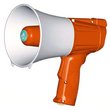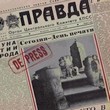|
|

Speakers' corner Following up our retro scope series of 2006 and 2007, 2009 and 2010 - here's the ever-continuing, never-stopping New Speakers' corner! Luna Kafé's focused eye on great events, fantastic happenings, absolute milestones, or other curious incidents from the historic shelves/vaults of rock. This piece will focus on a 1981 Norwegian classic. From the golden days of fresh, shiny and energetic new wave with a punky attitude. This threesome, or troika, wrote history around these shores. Jeden - dwa - trzy - cztery! A-a-a-a-a-a-a, a-a-a-a-a-a-ah! Pour me some Zubrówka.
De Press De Press was a so called new wave trio based in Oslo consisting of Andrej Dziubek Nebb (vocals and bass), Jørn Christensen (guitars and vocals) and Ola Snortheim (drums). Andrej came under the spell of Jimi Hendrix in the late 1960s and left Poland in 1970, originally to be a guitarist in the USA. Because of the Vietnam war he settled in Norway instead, as a sculptor. No one except Andrej himself seems sure if he was a political refugee or not. Anyway, he lost two fingers on his left hand around the time he left or fled from Poland. It didn't prevent him from playing the bass. On the contrary! The band's vinyl debut hit the streets late in 1980, a seven inch EP usually called Pond with four short and snappy punk influenced songs. Well, the shortest and snappiest of them was the word-less "Østavind" (Eastern Wind), with Andrej's howling vocals drenched in vodka that signalled a new and fresh attitude in the Norwegian rock underground, with inspiration from the east, obviously. It even included yodelling, and the band easily got away with it. The other songs, with lyrics sung in broken Polish-influenced English, were more ordinary, but still more than promising, and included shapes of things to come. On the night of 30. April/1. May 1981 the band participated at a big concert arranged and televised by the national broadcasting corporation to keep the kids and youngsters away from demonstrations in the streets, which had been a tradition on that particular night the last previous years. This meant De Press went along with the establishment to prevent rebellion and the band lost credibility in hardcore communities. The rest of us, that didn't own a video recorder, witnessed a half-drunk, very sweaty and pale Pole, maybe even feeling unwell, that sang quick and sharp songs in a strange tongue, even something about Norwegian fish pudding. The show also included banging with a hammer at an anvil. Of course they were an overnight sensation, literally, in Norway that is. The debut album was recorded around the same time with the prominent English John Leckie as producer (famous for his work with Be-Bop Deluxe, Public Image Ltd., early Magazine, Simple Minds and XTC at the time; later he won more fame and fortune with The Stone Roses' and Kula Shakers' debut albums, The Verve and Radiohead to name but a few; but he started as a studio worker at Abbey Road for Syd Barrett's second solo album as early as 1970 at a young age; afterwards he was involved in productions by Pink Floyd post Barrett, John Lennon, George Harrison and Paul McCartney post Beatles). De Press and another young Norwegian new wave band, The Cut, that also planned their debut album, had persuaded Leckie to come to Norway to help them out. He surely put his mark on the production and has to be honoured for the end result. I'm not sure if Jørn Christensen had improved his guitar abilities to a great extent since the EP or if it is Leckie's merit. Anyhow, along with Andrej's voice the guitar sounds and playing dominate the album, exquisite, occasionally sharp, occasionally airy. Instruments used on the album also include scythe, sickle and the aforementioned anvil. But, of course, the songs are the main asset of Block To Block. The band kicks off with two hit-aspiring songs with lyrics in Polish on each side of the LP. About the only words of "Kalhoz" is 'rabotajem b kalhozie' that supposedly means something like 'we all work at a state owned farm'. A punk-fuelled sing-along song that seemed to appeal even to drunken Norwegians, or maybe more correctly: especially to drunken Norwegians. The same goes even more so for "Bo Jo Cie Kochom", De Press' most famous song, about the female sheep shepherd that has an adventure in the meadow. The title means I love you... The rest of the album mainly includes more serious fun and songs, all of them still worth checking out and at least half of them classics. The title track, "Kic Me Rusia", "Forcd" and "Dobl Steyshen" (Andrej had his own way to spell in Eenglisj) all deal with the cold war, which indeed was cold at the time. The latter was about the divided Berlin ('on the other side of the wall'). My personal favourites are probably "Kejk" and "Moniuments" where the tempo is slowed down, haunting guitars and feelings dominate, with the spirit of late Joy Division hovering over the waters. Spine chilling stuff! On the other hand, the short instrumental "Velvet Walz" is, yes, you got it, a funny waltz! The final track "Conveyor Belt" is the closest to punk around, but with a ska influenced guitar towards the end, whereas "Peyshens" even includes a honky-tonk piano. Block To Block won a Spelemannspris, the Norwegian Grammy, for the best modern rock album of 1981. During the summer of 1981 the band toured Poland along with the two other new and most promising young Norwegian rock bands Kjøtt (meaning Meat) and The Aller Værste, culminating with a gig at the Lenin shipyard in Gdansk during the political unrest and heydays of Solidarność (the Solidarity labour union). Later in the year De Press released an even better vinyl platter, the 12 inch EP Lars Hertervig with lyrics sung in broken Norwegian. The title track, about a halfway famous, halfway forgotten 19th century Norwegian painter on the verge of insanity, developed the slower doomy direction of "Kejk" and "Monuments" even further. From then on the journey went slowly downhill. The second studio LP Product, also produced by John Leckie, was another goodie. But the lyrics were mainly in English and the album missed some of the Polish-Norwegian surprises and eccentricities of the previous recordings. Shortly after its release, the band fell to pieces due to internal conflicts. The partly live, partly studio recorded album On The Other Side, most famous for three songs from the Lenin shipyard gig, was released posthumously in 1983. By then Andrej Nebb had started another, even more adventurous group, Holy Toy. Jørn Christensen and Ola Snortheim continued their careers in several musical directions and collaborated in the mediocre successful new wave band Cirkus Modern and the more successful folk music project Langsomt Mot Nord (Slowly Towards The North). By 1990, the original trio made a comeback and released a few more albums before the Polish and Norwegian camp fell completely out in 1993. Andrej later revived the band with Polish musicians and has released numerous albums in Poland both before and after the turn of the millennium. But the band has never regained the momentum of Block To Block and Lars Hertervig of 1981. Block To Block has been voted the best album of Norwegian rock history on a few occasions. Well deserved, if you ask me. Well, almost. Who knows, I guess it could have been voted the best album of Polish rock history, too, if it had been distributed there 30 years ago. Copyright © 2011 JP
|
| © 2011 Luna Kafé |
